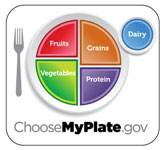

Establishing nutrition standards creates a foundation of objective criteria that can be implemented consistently. Very often, nutrition standards are incorporated into written policies at various levels. In July 2012, the United States Department of Agriculture (USDA) released new nutrition standards that school districts across the nation implemented for the 2012-2013 school year. The changes outlined in Federal Register 7 CFR Parts 210 and 220 - Nutrition Standards in the National School Lunch and School Breakfast Programs; Final Rule came at a critical time in society when nearly 1 in 3 children are considered at risk for preventable health conditions.
The new nutrition standards for Child Nutrition Programs aimed to increase the availability of fruits and vegetables, whole grain bread products, and fat-free and low-fat dairy products over the course of implementation. In addition, meals will provide lower amounts of saturated fat and sodium levels while eliminating trans fat from student meals. Because of this legislation, children of all socioeconomic backgrounds have access to healthier foods which is critical in a society that has overweight yet undernourished children.
Under the new legislation, the School Food Service (SFS) Department will continue to utilize Offer versus Serve (OVS). OVS allows students to decline some of the food items (components) offered in school breakfast or school lunch meals. The goal of OVS is to reduce food waste and permit students to select the foods they prefer as part of a complete meal. One major OVS change that has been implemented throughout the past few years, is that students are required to select either a fruit or vegetable component as part of their reimbursable meal.
Below are the required components that must be offered to students per meal, and what the students are required to select to create a complete reimbursable meal:
1. For breakfast, students must be offered 4 components: Protein, Grains, Fruit, and Milk. Students may select three or four of the above food groups to complete their meal. At least one of these choices must be from the fruit group.
2. For lunch, students must be offered 5 components: Protein, Grains, Fruit, Vegetable, and Milk. Students may select three, four, or five of the above food groups to complete their meal. At least one of these choices must be from the fruit or vegetable group.
The school environment is one of several settings that can influence children’s food choices and eating habits. Therefore, meals should be designed to ensure that the foods offered meet or exceed the recommendations. In addition, staff should serve as role models for students by demonstrating healthy food and physical activity habits. The following are several key requirements set forth by the USDA to improve school lunch and breakfast meal designs:
- default_titleOffer a variety of fresh produce to include those prepared without added fats, sugars, refined sugars, and sodium
- default_titleOffer a variety of vegetables daily to include specific subgroups as defined by dark green, red/orange, legumes, and starchy
- default_titleOffer whole grain products – half of all grains need to be whole grain-rich upon initial implementation and all grains must be whole grain-rich two years post implementation
- default_titleOffer fluid milk that is fat-free (unflavored and flavored) and low-fat (unflavored)
- default_titleOffer meals that are designed to meet specific calorie ranges for age/grade groups
- default_titleEliminate trans fat from school meals
- default_titleRequire students to select a fruit or vegetable as part of a complete reimbursable meal
- Show More
The 2013-2014 school year marked the second year of implementing the newly required Nutrition Standards. The School Food Service (SFS) Department continued to use a team approach to thoroughly review the Nutrition Standards in the National School Lunch and School Breakfast Programs; Final Rule. Collectively, this team determined the procedures in which to implement the required changes, and the strategies in which to communicate them.
Below is a list of strategies that the SFS Department utilized during the 2013-2014 school year to communicate the changes:
- default_titleHost mandatory trainings for all SFS employees to attend
- default_titleIncluded information on the Nutrition Standards in the yearly marketing booklet that was sent to every student household in the District
- default_titleProvided information on the SFS website - Menu Information webpage as well as within the breakfast and lunch menus
- Show More
In addition to the Nutrition Standards for the National School Lunch Program, the USDA announced the release of Smart Snacks in School guidelines. These guidelines aimed to establish nutrition standards for all foods and beverages sold in schools outside of the reimbursable meal program. The administrative team met numerous times to review the new legislation and submitted comments to USDA on the implications of the new rule.
To prepare for the July 1, 2014 implementation of the Smart Snacks in School guidelines, action plans were developed to include communication methods, surveys were designed to gather feedback from middle and high school managers, all food and beverage items were analyzed for compliance, and presentations were made to SFS managers. The SFS Department also ensured that language specific to the Smart Snacks in School guidelines were included in the District's beverage and vending contract, Solicitation No. 14C-42D Vending Services which went out for bid in April 2014, the proposed School Food Services Management Policy (6.185) and the Wellness Promotion Policy (2.035). Lastly, the SFS Department was invited to participate in the CAO/A&S meeting in August 2014 to communicate the new legislation with District administrators and principals.
Body Mass Index (BMI) is a standard that can be applied to most people in order to define obesity. BMI is calculated from a person’s weight and height and is often used to screen for weight categories that may lead to health problems.
Weight Categories based on BMI
BMI
Weight Status
Below 18.5
Underweight
18.5-24.9
Normal
25.0-29.9
Overweight
30.0 and Above
Obese
Calculating BMI
Measurement Units
Formula and Calculation
Kilograms and meters (or centimeters)
Formula: (weight (kg) / [height (m) x height (m)])
Pounds and inches
Formula: (weight (lb) / [height (in) x height (in)]) x 703
Recent data from the Centers for Disease Control (CDC), indicates that 1 out of every 3 children are obese or overweight before their 5th birthday. When children are overweight or obese they are more likely to have high blood pressure, high cholesterol, and type 2 diabetes. In addition, they are more likely to become obese adults. Unfortunately, the latest Youth Risk Behavior Survey reported 12% of Florida students were obese. Now is the time to educate these students and encourage the development of healthy eating habits.
MyPlate and the 2010 Dietary Guidelines for Americans, both supported through the USDA, are resources that Americans can use to make healthy food choices and be physically active every day.
- default_title
MyPlate is split into four sections each representing a different type of food – protein, whole grains, fruits, vegetables, and dairy. The sections vary in size depending on the recommended portion, with dairy included on the side. This food guidance system promotes energy balance by enjoying your food and avoiding oversized portions. It also encourages increasing fruits and vegetables by filling half the plate with food from those groups, making half of all grains whole grains, and switching to fat-free low-fat milk.
- default_title
The Dietary Guidelines for Americans focuses on balancing calories with physical activity and encourages Americans to consume more healthy foods like vegetables, fruits, whole grains, fat-free and low-fat dairy products, and seafood while reducing their intake of sodium, saturated fat, trans fat, added sugars, and refined grains.
- Show More

